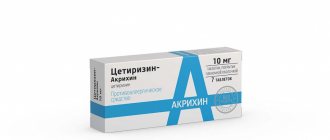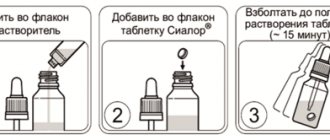Polydexa is an original French drug based on two antibiotics and a glucocorticosteroid. Available in two forms - ear drops and phenylephrine nasal spray. The medication is sold strictly according to prescription and is not suitable for self-medication. Since it contains antibiotics, with uncontrolled use there is a high risk of developing resistance of pathogens to the active components.
Pharmacies offer many analogues of the drug, available freely without a doctor's prescription. Before purchasing, you should study the instructions for use and consult with a specialist.
Compound
1 ml ear drops contains:
- neomycin sulfate – 10 mg (6500 units);
- polymyxin B sulfate – 10,000 units;
- Dexamethasone sodium methylsulfobenzoate – 1 mg.
And also excipients:
- lithium chloride;
- thiomersal;
- citric acid;
- sodium hydroxide;
- polyethylene glycol 400;
- polysobate 80;
- distilled water.
The nasal aerosol contains as active ingredients:
- neomycin sulfate 6500 units/ml;
- Dexamethasone sodium metasulfate benzoate – 250 mcg/ml;
- polymyxin B sulfate – 10,000 units/ml;
- phenylephrine hydrochloride – 2.5 mg/ml.
The excipients of the nasal spray are somewhat different from the composition of the ear drops:
- methylparaben;
- lithium chloride;
- lithium hydroxide;
- lemon acid;
- macrogol 4000;
- polysorbate 80;
- purified water to the required amount of medicine.
pharmachologic effect
The pharmaceutical drug Polydexa is a combination drug, which, according to its therapeutic effect, is classified as anti-inflammatory and antimicrobial. The active components included in the ear drops, in particular Neomycin and Polymyxin, can suppress such types of pathological microorganisms as Staphylococcus aureus, Escherichia coli, Klebsiella pneumoniae, Pseudomonas aeroginos, Haemophilus influenzae. Unfortunately, some types of streptococci, staphylococci and anaerobic bacteria remain resistant to the influence of the pharmaceutical drug.
The nasal spray has the same broad therapeutic effect on the nasal mucosa as the pharmaceutical form of the ear medicine. Also, its beneficial properties are complemented by phenylephrine , the vasoconstrictor effect of which reduces nasal congestion and greatly facilitates nasal breathing.
Indications for use
Ear drops are used for the following pathologies:
- external and otitis media (only if there is no defect in the eardrum);
- infected eczema of the ear canal.
Polydexa with phenylephrine in the form of a nasal aerosol is used for:
- inflammatory and infectious diseases of the nasal cavity, pharynx and paranasal sinuses;
- acute and chronic rhinitis ;
- rhinopharyngitis;
- sinusitis.
Analogs for ears
Dioxidine
Manufacturer: Novosibkhimpharm, Russia
Release form: solution in ampoules
Active ingredient: hydroxymethylquinoxaline dioxide
The drug Dioxidin is often prescribed as an antimicrobial agent for infectious and inflammatory diseases of the ears and nose. Produced in ampoules of 5 and 10 ml, 10 pieces in a package. Two ampoules are required for treatment.
The medicine is dispensed by prescription, strictly as prescribed by the doctor.
Otofa
Manufacturer: Farmaster, France
Release form: ear drops
Active ingredient: rifamycin
Otofa is used as prescribed by a doctor for otitis media and externa, and is an analogue of Polydex. Contains an antibacterial component, approved for use in pediatrics.
Anauran
Manufacturer: Zambon S.P.A., Italy
Release form: ear drops
Active ingredients: polymyxin B, neomycin, lidocaine
Anauran - ear drops similar to Polydex. The difference is that instead of the anti-inflammatory hormone dexamethasone, they contain the local anesthetic lidocaine. Used for external and otitis media.
Candibiotic
Manufacturer: Glenmark, India
Release form: ear drops
Active ingredients: beclomethasone propionate, chloramphenicol, clotrimazole, lidocaine
The candibiotic combines 4 actions at once and is used for external and otitis media:
- antibacterial;
- antimicrobial;
- anesthetic;
- anti-inflammatory.
Can be used in children from 6 years of age.
Important! Drops in the ear are used only after examination and consultation with a specialist. For many, a contraindication is perforation of the eardrum, which is diagnosed by a doctor.
Contraindications
- increased individual sensitivity to the constituent components of the pharmaceutical drug;
- hereditary or acquired intolerance to the active substances of the drug;
- infectious or traumatic damage to the eardrum;
- closed angle glaucoma or suspicion of this pathology;
- period of pregnancy and breastfeeding ;
- children under 2.5 years of age;
- nosological entities caused by varicella or herpes ;
- albuminuria or urinary retention and kidney disease, which lead to these pathological conditions;
- a tendency to ventricular tachycardia of the pirouette or taking pharmaceutical drugs that contribute to the appearance of this anomaly.
Polydexa or Otipax
Manufacturer: Biocodex, France
Release form: ear drops
Active ingredient: lidocaine, phenazone
Otipax ear drops are a substitute for Polydex, used for otitis media, barotraumatic otitis and inflammation after a cold. It has analgesic and anti-inflammatory effects. Used in pediatrics. Limitations for use include perforation of the eardrum and individual intolerance to the components.
Polydexa has a different purpose - it is used for external otitis and eczema.
The choice of drug should be entrusted to the doctor in order to make a diagnosis and exclude perforation of the eardrum.
Side effects
Adverse effects of treatment with ear drops appear only in isolated cases. Local allergic reactions may occur , for example:
- hives;
- skin itching;
- rashes.
Since the nasal aerosol contains a larger number of active ingredients and realizes its therapeutic effects through the mucous membrane, side effects are more likely to occur. As in the case of ear drops, first of all, similar allergic reactions , which are complemented by a feeling of dryness in the nasal passages. Adverse consequences of a systemic nature are possible only with a long course of conservative treatment or with dosages of the pharmaceutical drug that significantly exceed those prescribed by the instructions. In this case, you may experience:
- headache;
- insomnia;
- increased blood pressure;
- tachycardia;
- tremor;
- microcirculatory reactions in the form of pallor or redness.
Instructions for Polydex (Method and dosage)
Ear drops are widely popular among patients in otolaryngological hospitals, since this form of the drug is extremely easy to use and has a meager list of side effects that appear only in isolated cases. Also, no reliable data on an overdose of Polydexa for the ears has been described in the medical literature.
Instructions for use of Polydexa are practically the same in pediatric practice and for adults. So the dosage for children, as well as for the older category of patients, is 1-2 drops for the ears in each ear canal, 2 times a day. For appropriate indications and severe disease in adults, the amount of the drug used can be increased to 5 drops. Before carrying out the manipulation, it is recommended to slightly warm the medicine .
The duration of the course of conservative therapy is 6-10 days.
Phenylephrine spray is used intranasally. It is as easy to use as ear drops. During manipulation, the bottle with the pharmaceutical drug must be held vertically and the head tilted slightly forward, so the active ingredients will irrigate a large area of the mucous membrane of the nasal cavity.
The dosage of the drug is 1 injection 3 times a day in each nostril. For adult patients and children over 15 years of age, the frequency of use of the pharmaceutical drug can be increased to 5 times a day if required by therapeutic indications.
The course of treatment usually takes from 5 to 10 days.
Polydexa or Protargol
Manufacturer: Pharmvilar, Kirov FF, Russia
Release form: powder with solvent
Active ingredient: silver proteinate
Synonyms: Sialor
Protargol is an analogue of Polydex for children and adults based on silver ions with an antiseptic effect. Available in powder and solvent form, when combined they form nasal drops. The resulting solution is stored for up to 30 days in a place protected from light (cabinet).
Protargol is a nasal analogue that is cheaper than Polydexa and is used for rhinitis and sinusitis for up to 5-7 days. After instillation, a film is formed on the mucous membrane, preventing the proliferation of the pathogen. Dry mouth, burning sensation, tingling sensation, and allergic reactions are also possible.
Polydexa has a wider spectrum of action and is used as prescribed by a doctor.
What to replace Polydex with depends on many factors (cause, symptoms of the disease, duration, age of the patient, restrictions, previously used drugs, etc.). Polydex analogues for children for the nose and ear are selected with a pediatrician. For treating adults, consulting a doctor is also important.
Interaction
Drug interactions that produce clinical effects occur due to the content of phenylephrine in the nasal aerosol. The simultaneous use of this pharmaceutical form of Polydex with guanethidine enhances the hypertensive effects of the active components of the spray. prolonged mydriasis may occur . Therefore, for absolute indications for the use of these drugs in combination therapy, constant monitoring by the attending physician and appropriate clinical tests are recommended.
special instructions
Ear drops are not recommended for use if there is a perforated eardrum . In this case, there is a possibility of toxic effects of the active components of the drug on the auditory or vestibular system.
The drug should be used with extreme caution if a fungal or viral etiology of the disease is suspected. It is recommended to conduct additional studies before starting a course of conservative therapy.
Among the active ingredients of the pharmaceutical drug is dexamethasone , a biologically active substance that doping control with a long course of treatment or dosages significantly higher than those specified in the instructions (the active ingredients can have a systemic effect).
It is impossible to say for sure whether Polydexa is an antibiotic or not, although this question often comes up on pharmaceutical forums devoted to this topic. Of course, the drug contains active components of an antibiotic nature, for example, Polymyxin B or Neomycin, however, by their nature, neither the nasal spray nor the ear drops are classified as an antibiotic. Another positive feature of this drug is the possibility of simultaneous use with systemic antibiotics, if there are appropriate medical indications confirmed by the attending physician.
Polydexa - cheaper analogues, list with prices, comparison of effectiveness
Polydexa is a modern nasal antibacterial drug that appeared on the domestic market relatively recently, but has already established itself as a reliable remedy against bacteria.
The advantage of polydexa lies not only in the fight against pathogenic bacterial microflora, but also in the ability to have a vasoconstrictor, anti-edematous and anti-inflammatory effect.
This therapeutic complex is carried out thanks to the complex composition of the drug. It contains two antibiotics (neomycin and polymexin B sulfates), as well as agents that eliminate swelling and inflammation (phenylephrine hydrochloride and dexamethasone).
The drug is used after 2.5 years. It is widely used for infectious processes of the nasopharynx, especially in cases where signs of serious inflammation appear: pus, “green” in the snot, prolonged runny nose, pain in the projection of the maxillary sinuses, etc.
Polydexa is usually used up to three times a day, and the course of treatment lasts on average 5–7 days. More precise rules for the use of the drug are established by a pediatrician, ENT specialist or therapist. For the youngest patients, Polydex is indicated only once a day.
The price of Polydex (a 15 ml bottle made in France) is about 320 rubles. Not all patients may be satisfied with this cost, although Polydex cannot be called a super expensive product.
In such cases, cheaper analogues are selected, and Polydex is canceled.
It is also possible that the patient is allergic to some component of the composition, and one has to think about which alternative is better to choose.
How often is Polydex replaced?
Most often, when considering analogues, doctors suggest replacing Polydex with Isofra spray. It has a different composition (only one substance - framycetin), but the price is practically the same. Therefore, isofra will not be suitable as a cheap remedy, but if the problem is intolerance to polydex, then isofra will be appropriate.
Diseases of the nasopharynx are often accompanied by a symptom such as “shooting ear.” It seems that there is no otitis media yet, but all the warning signs of its possible appearance are there. Polydexa wins in this case, because It can also be used for ear drops.
Isofra is a targeted antibacterial nasal drug; it is even called “an analogue of Polydex for the nose.” Isofra acts only on bacteria; it does not eliminate the accompanying symptoms.
Read more about which is better – isofra or polydex.
How to choose the right analogue?
Let's say that the patient is over 2.5 years old and was prescribed Polydex. After several doses of the drug, the patient complained of a burning sensation and severe swelling, which did not go away after 2–3 minutes. Subsequent injections also brought negative symptoms to the patient.
Here the doctor has to follow the following tactics.
- Firstly, the analogue must be selected according to the permissible age of the patient, and also that the composition of the product must include an antibiotic, or, in extreme cases, an antiseptic.
- It all depends on the clinical picture of the disease. If we are dealing with high body temperature, aggravated symptoms, and purulent discharge, then in this case only an antibiotic is needed, both locally and systemically.
- If a bacterial runny nose is just beginning, when yellow or green snot appears, and the patient’s body temperature is normal, or does not exceed 37.2 degrees (in children under three years of age), you can try to treat the runny nose with antiseptic solutions, i.e. . Nasal drops (similar to Polydex) are suitable.
- In any case, before starting treatment, the patient should be examined by an otolaryngologist to exclude the development of sinusitis, other sinusitis and otitis media. We are not even talking about self-medication with antibacterial agents.
It is advisable that before starting treatment, the doctor takes a microflora culture from the nasopharynx, then getting into the top ten will not be a problem, and the right remedy against a particular bacterium will surely be found.
The disadvantage of such diagnostics is the duration of bacterial culture, usually at least 5 days, and treatment cannot be delayed. Then drugs for bacterial rhinitis are prescribed at random. In most cases, such therapy brings results.
Cheap analogues of Polydex - list with prices
Today, the following drugs can be offered as cheap analogues:
- isofra (spray, 15 ml) – 300 rubles (slightly cheaper);
- Okomistin (eye drops, 10 ml) – 150 rubles;
- sialor (drops, 10 ml) – 260–290 rubles;
- miramistin (solution, 50 ml) – 240–260 rubles;
- collargol (drops) – 150 rubles;
- chlorophyllipt (oil solution, 20 ml) – 150 rubles.
Analogues of Polideksa
Level 4 ATC code matches:
Candibiotic
This drug is famous for its uniqueness in the market of pharmaceutical products in otolaryngology. There is only one similar medicine - Maxitrol made in Belgium. The active components of which also include neomycin and polymyxin. The price of analogues is slightly higher, since they are presented in a wider range of release forms, however, domestic pharmacy kiosks, as a rule, supply drops of 5 ml.
Polydexa or Sofradex - which is better in the ear?
Manufacturer: Sanofi India Limited, India
Release form: drops
Active ingredients: dexamethasone, framycetin, gramicidin
Sofradex is an analogue of Polydex ear drops, with a combined composition. It also contains a glucocorticosteroid and two antibacterial components and has an anti-inflammatory and antibacterial effect.
In otolaryngology, an analogue is used for otitis externa, it is more expensive. Which is better – Sofradex or Polydex, individually. The drugs are similar in terms of the included groups of substances and properties.
Polydexa for children
The pharmaceutical drug Polydexa is often used in pediatric practice , since inflammatory pathologies of the nose and ear are common in children. As soon as a little child crosses the threshold of the house, coughing , snot, runny nose , ear pain and other manifestations of rhinitis , sinusitis , otitis or other inflammatory diseases begin. The medicine in the form of drops or nasal aerosol can be used in children over 2.5 years of age . The instructions for this medicine do not give any more significant instructions, that is, the pharmaceutical drug is used extremely easily, this does not even require completion of any special training courses or medical knowledge.
Separately, it should be noted that the price of the drug does not greatly upset parents and does not put a strain on the family budget. Therefore, having Polydex in stock is a simple task. Do not forget about the recommendations for the pharmaceutical product. Most thematic forums praise Polydex as a substance that allows, in a record short course of conservative therapy, to eliminate the problem of such annoying rhinitis, sinusitis or otitis in both the adult category of patients and younger ones.
From a medical point of view, taking Polydexa by children is also approved. Reviews from qualified specialists confirm that the active components of the drug allow you to quickly and effectively get rid of inflammatory pathology, even in pediatric practice, when the young body has not yet sufficiently formed its own immune systems.
Analogues in the nose
Derinat
Manufacturer: FZ Immunolex, Russia
Release form: solution
Active ingredient: sodium deoxyribonucleate
Derinat is a domestic analogue of Polydex nasal spray. Available in bottles, the cost depends on the additional nozzle of drops or spray. The medicine is an immunomodulatory drug and helps to activate the body’s own forces to fight viral, fungal, and bacterial infections.
In otolaryngology, Derinat is used as an auxiliary measure for rhinitis, sinusitis, and sinusitis. The advantage of the analogue is that it is cheaper than Polydex spray, it is safe, there are no contraindications (except for reactions of individual intolerance).
Vibrocil
Manufacturer: Novartis, Switzerland
Release form: nasal drops
Active ingredient: phenylephrine, dimethindene
The drug Vibrocil combines the properties of its constituent components - it fights allergic reactions, eliminates swelling of the mucous membrane, redness, nasal discharge, constricts blood vessels, and normalizes breathing. In pediatrics, Vibrocil has been used since one year.
Indications for the use of this Polydex analogue are rhinitis (acute, allergic, chronic), sinusitis, as an adjuvant for otitis media to restore breathing.
Sinupret
Manufacturer: Bionorica, Germany
Release form: drops, tablets
Active ingredient: extracts of medicinal plants
The drug Sinupret is used in pediatrics from 2 years of age and for the treatment of adults with sinusitis. Helps reduce inflammation in the sinuses, liquefy and drain exudate.
The drops contain alcohol, so they are used with caution for diseases of the liver, brain, head injury and alcoholism.
Reviews about Polydex
Polydex ear drops enjoy a good reputation on relevant thematic forums and pharmaceutical Internet resources. The majority of patients who have taken a course of this drug leave extremely positive reviews, calling for the active use of drops for the conservative treatment of diseases of the outer and middle ear.
Reviews from doctors from a professional point of view confirm that the pharmaceutical drug Polydexa really ranks first among measures of conservative therapy in otolaryngology. Both ear drops and nasal spray effectively eliminate the cause of the inflammatory process that underlies the entire disease, and therefore the use of such a drug is classified as etiological sanitation.
Not only adults, but also children are satisfied after undergoing treatment with Polydexa, because the pharmaceutical drug restores dryness of the nasal mucosa, allows free nasal breathing, hearing in full force and, most importantly, playing with friends on the street again after just 6- 10 days, because the conservative therapeutic course is minimal in this field of pharmaceuticals.
Polydex price, where to buy
The price of ear drops in the Russian Federation is about 250 rubles.
You can buy this form of pharmaceutical drug in Ukraine for the equivalent cost of 122-138 hryvnia.
Nasal spray can be purchased at pharmacy kiosks in both countries for 350 rubles or 150 hryvnia, respectively.
- Online pharmacies in RussiaRussia
- Online pharmacies in UkraineUkraine
- Online pharmacies in KazakhstanKazakhstan
ZdravCity
- Polydexa with phenylephrine nasal spray.
15ml UNDEFINED 467 RUR order - Polydexa ear drops 10.5mlPharmaster
RUB 337 order
Pharmacy Dialogue
- Polydexa ear drops bottle 10.5 ml + pipetteLaboratoires Bouchara-Recordati
RUB 338 order
- Polydexa with phenylephrine (15ml spray)Laboratoires Bouchara-Recordati
RUR 464 order
show more
Pharmacy24
- Polydexa with phenylephrine 15 ml spray Sofartex, France
134 UAH. order - Polydexa 10.5 ml drops Bouchard Laboratories Recordati, France
122 UAH order
PaniPharmacy
- Polydexa with phenylephrine liquid Polydexa with phenylephrine nasal spray 15ml France, Sofartex
154 UAH order
- Polydexa liquid Polydexa u/k 10.5ml France, Lab. Bouchara Recordati
138 UAH order
show more
Polydexa or Isofra - which is better?
Manufacturer: Sofartex, France
Release form: nasal spray
Active ingredient: framycetin
Synonym: Tramicent
Isofra is an analogue of Polydex nasal spray, containing one component - framycetin. Refers to antibacterial drugs, affects pathogenic sensitive microflora - gram-positive and gram-negative bacteria. The medicine is used for sinusitis (sinusitis), nasopharyngitis, rhinitis, green snot, and adenoids. The price of the medicine is slightly lower than Polydex - 330–440 rubles.
Polydexa contains two antibiotics that enhance each other, and a glucocorticosteroid with pronounced anti-inflammatory properties. The composition of the drug is more effective and stronger. An additional substance is phenylephrine, which normalizes breathing by constricting blood vessels and eliminating redness and swelling of the nasal mucosa.
What is best for a child is individual. Both drugs are prescribed by a doctor and are available with a prescription.
Difference between drugs:
- composition – Isofra has only an antibacterial effect, Polydexa has an antibacterial, anti-inflammatory, vasoconstrictor effect;
- due to its composition, Isofra is used in pediatrics from the age of 1 year, Polydexa - from 2.5 years, strictly as prescribed by the doctor;
- an analogue of Polydex spray with Phenylephrine Isofra is slightly cheaper - up to 50 rubles;
- Polydex has more contraindications for use than its analogue.
Both medicines are effective, imported, and of high quality. The choice in favor of one or the other is made by the doctor based on medical history. The undoubted advantage of the medicines is that they are original. This means that they have been sufficiently studied, there is clinical research data on the safety and effectiveness of using nasal spray in adults and children.







